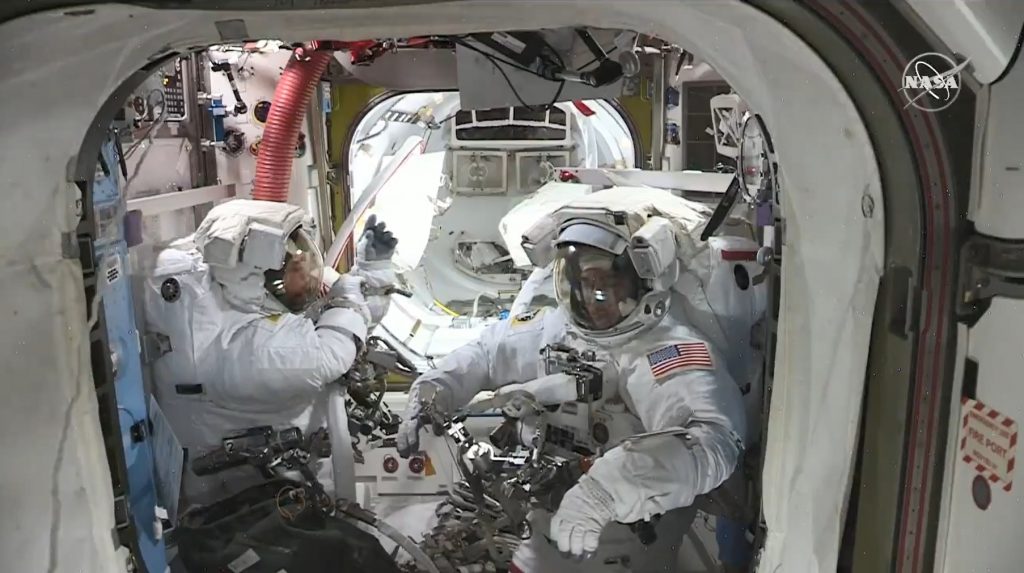
Two of the United States’ most seasoned spacewalkers have completed the replacement of batteries in one of two power channels on the far-starboard S-6 truss segment on the International Space Station (ISS). Expedition 63 Commander Chris Cassidy and Flight Engineer Bob Behnken worked with smooth professionalism for over six hours on Friday, 26 June, to pluck out aging nickel-hydrogen batteries in Channel 1B and replace them with smaller and more capable lithium-ion units, which will continue to support the station’s power-generation needs through the end of its operational lifetime. Both men were embarking on their seventh career spacewalks.
They will wrap up their work on Channel 1B in a second session of Extravehicular Activity (EVA) next week, with planning still in the mix to determine if they will also tackle the second power channel, Channel 3B in the mid-July timeframe. Today’s spacewalk also marked the first time that two former Chiefs of the Astronaut Office have executed an EVA together.
This hot and heavy summer of spacewalking is expected to close out a three-year-plus campaign of EVA and robotics work to swap out the big old nickel-hydrogen batteries with smaller and more capable lithium-ion ones. And with today’s EVA, that work is now well into its homestretch. Each of the station’s four massive truss segments—P-6 and P-4 on the “port” side, S-6 and S-4 on the “starboard” side, together with adjoining structural members—were installed by successive Space Shuttle crews between November 2000 and March 2009.
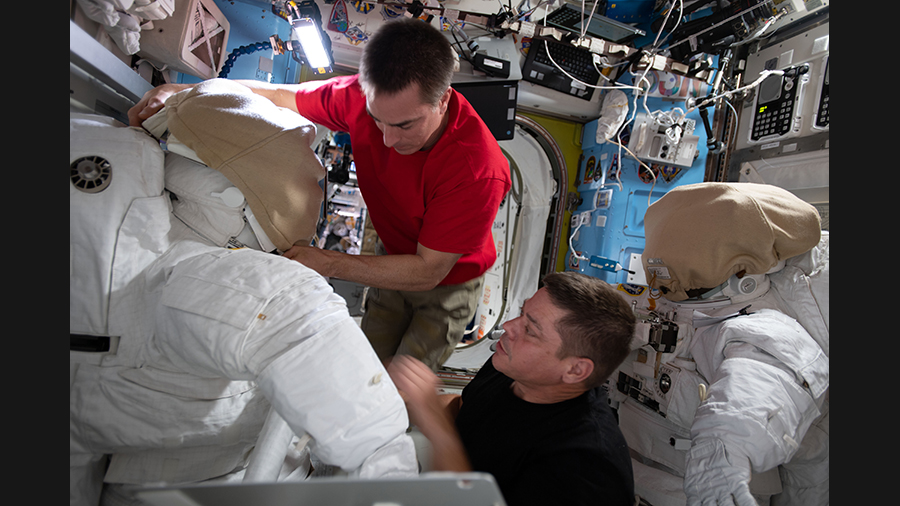
Each truss houses a pair of giant Solar Array Wings (SAWs) and two power channels to contribute to the station’s requirement for electrical energy, power storage and distribution and cooling. And within each truss, 12 nickel-hydrogen batteries stored and routed electrical power from the SAWs to feed on-board systems. The batteries were designed for a functional lifetime of 6.5 years. Although those of the oldest truss (P-6) were replaced with like-for-like batteries by shuttle spacewalkers in July 2009 and in May 2010, the other retained their original units for much longer. Interestingly, Cassidy participated in the changeout of those like-for-like batteries during his first spaceflight and more recently played a critical role in developing the EVA choreography for the S-6 battery swap task.
Early in the last decade, plans were laid to fit new lithium-ion batteries, which were smaller, greatly exceeded the storage capacity of their predecessors and could handle a larger number of charge/discharge cycles over a full decade. Each lithium-ion battery takes the place of two nickel-hydrogen ones, with an adapter plate closing the circuit. As a consequence, 48 nickel-hydrogen batteries in total will be replaced with 24 lithium-ion units. In January 2017, spacewalkers Shane Kimbrough, Peggy Whitson and Thomas Pesquet conducted two EVAs to replace batteries in the S-4 truss. Then, in March 2019, spacewalkers Anne McClain, Nick Hague and Christina Koch did likewise for the P-4 truss. More recently, between October 2019 and last January, spacewalkers Koch, Drew Morgan and Jessica Meir tackled the P-6 truss.

Since the S-4 and P-4 trusses reside near the “center” of the space station, they could be reached more easily and the robotic arm’s Dextre “hand” could do much of the heavy lifting of the batteries. However, P-6 and S-6 sit much further “outboard”, beyond the reach of Dextre and the 57.7-foot-long (17.6-meter) Canadarm2, which places added complexity in terms of getting the spacewalkers, their tools and the batteries out to the more distant worksites. As such, whereas the S-4 and P-4 battery swaps required only two EVAs apiece, the P-6 and S-6 campaigns were predicted to require as many as five EVAs per truss: two for each power channel, plus an “extra” spacewalk if needed. (Actual experience on the recent P-6 battery swap allowed the entire task to be done in four EVAs.) Replacement batteries for the two S-6 power channels—identified as 1B and 3B—arrived at the space station last month aboard Japan’s H-II Transfer Vehicle (HTV-9).
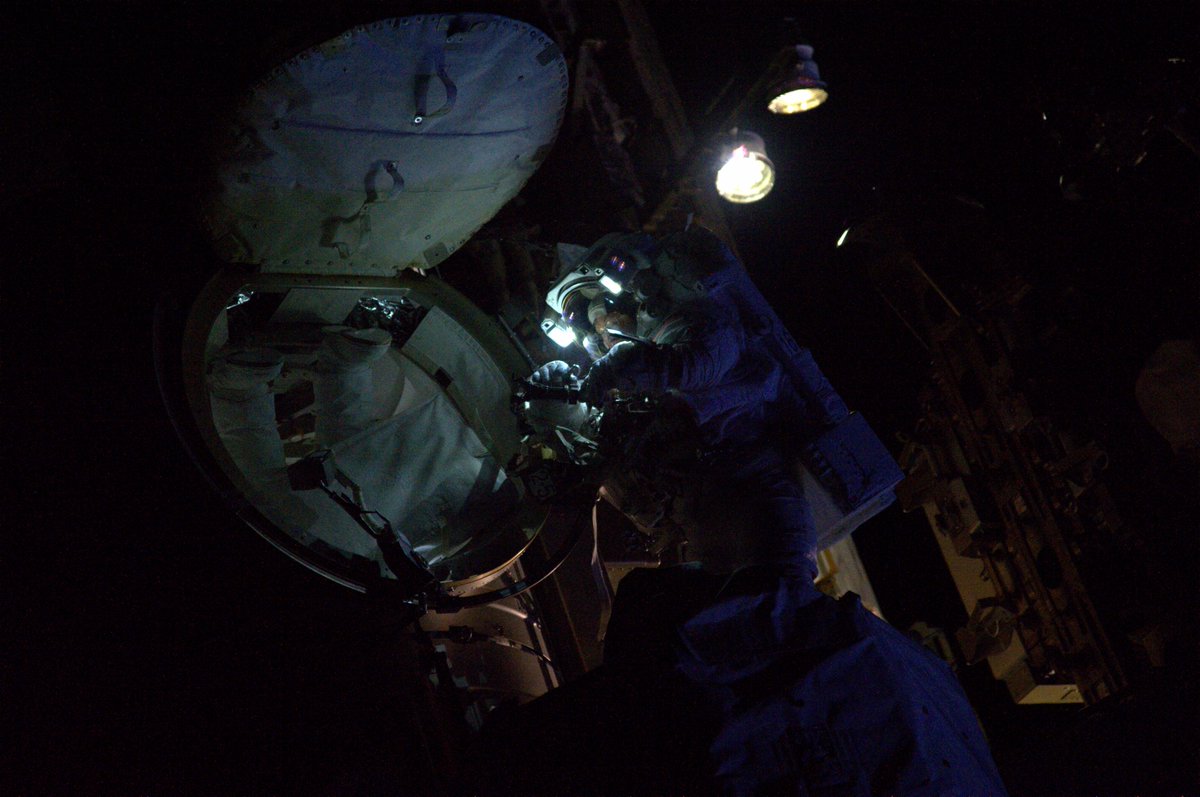
Following the arrival of Dragon Endeavour last month, efforts have steadily entered high gear to use Demo-2 crewmen Behnken and Doug Hurley to assist Cassidy with the battery swaps. And in recent weeks, they have configured space suits and tools and performed suited “fit-checks” in the Quest airlock. With Cassidy and Behnken outside, Hurley was to be the prime robotics operator of Canadarm2—positioning HTV-9’s Exposed Pallet (EP) to the spacewalkers to allow them to retrieve the new batteries and install the old ones for disposal—and Expedition 63 crewmate Ivan Vagner would assist with suit-up.
That suit-up got underway in the small hours of Friday morning and at 2:50 a.m. EDT the spacewalkers began a standard pre-EVA protocol of pre-breathing on masks and performing In-Suit Light Exercise (ISLE) inside Quest’s inner equipment lock. At length, Hurley and Vagner maneuvered the pair and their tools through the hatch from the inner equipment lock into Quest’s outer crew lock. Depressurization of the crew lock then commenced, reaching a condition of near-vacuum. At 7:32 a.m. EDT, Cassidy and Behnken transferred their suits’ critical life-support utilities over from station power to internal batteries. This action officially kicked off U.S. EVA-65.
From the Mission Control Center (MCC) at the Johnson Space Center (JSC) in Houston, Texas, a team led by Flight Director Royce Renfrew and Ground Intravehicular (IV) Capcom Jasmin Moghbeli—newly graduated from Astronaut Candidate training earlier this year—would support the Expedition 63 crew throughout today’s EVA. Cassidy and Behnken performed “buddy checks” of each other’s suits, before heading for the S-6 worksite.
Working at least 90 minutes ahead of schedule, the spacewalkers labored to remove of the six nickel-hydrogen batteries from Channel 1B and install two of the three new lithium-ion batteries and two of the three adapter plates. This placed them significantly ahead of the timeline and on their next EVA on Wednesday, 1 July, Cassidy and Behnken will remove the sixth nickel-hydrogen battery from Channel 1B, install a third lithium-ion unit and another adapter plate. Returning to the airlock, EVA-65 concluded after six hours and seven minutes. It places Behnken in the Top Twenty list of most experienced spacewalkers, with a cumulative total of 43 hours and 40 minutes across his seven career EVA. Cassidy sits a little further behind with 37 hours and 21 minutes.




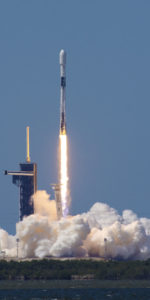
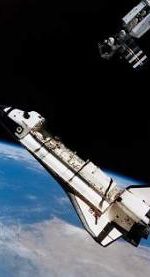
When you’re in zero G, can you be a “heavyweight?” 😉 Maybe “Massive Spacewalkers Smoothly Complete S-6 Battery Swap”